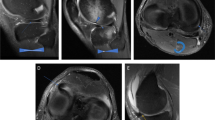Abstract
Objective
To describe MRI changes of the coracoclavicular bursa in patients presenting with shoulder pain and examine whether there is an association with coracoclavicular distance measurements.
Methods
Retrospective analysis of 198 shoulder 3T MRI scans for patients with shoulder pain was performed. Two musculoskeletal trained radiologists read all MRI scans. Inter-reader and intra-reader agreements for the bursal changes were assessed using the Kappa coefficient. The coracoclavicular distance was stratified into three intervals: < 5 mm, 5–10 mm, and > 10 mm. Statistical analysis for the coracoclavicular bursal changes and coracoclavicular distance was conducted using Fisher’s exact test.
Results
Coracoclavicular bursal changes were detected in 9% (n = 18/198) of patients. There was a statistically significant association between coracoclavicular distance (< 5 mm) and the presence of coracoclavicular bursal changes (p-value = 0.011). All patients (100%, n = 18/18) with coracoclavicular bursal fluid presented with shoulder pain with 44.5% of the patients (n = 8/18) describing anterior shoulder pain. A statistically significant association was detected between coracoclavicular bursal changes and anterior shoulder pain (p-value = 0.0011). Kappa coefficient for the bursal changes inter-reader agreement was moderate (0.67) and the intra-reader agreement was almost perfect (0.91).
Conclusion
Coracoclavicular bursal changes were detected in 9% of shoulder MRI scans and were associated with reduced coracoclavicular distance (< 5 mm) suggesting an underlying mechanical disorder such as a friction or an impingement process. Documenting coracoclavicular bursal changes in the MRI report could help address patients’ concerns and guide further management particularly in the context of shoulder pain and coracoclavicular distance of less than 5 mm.


Similar content being viewed by others
References
Gruber W. Dic Obcrschulterhakcnschlcimbcutcl, Bursac mucosac supracoracoideac. Mein Acad Sci St Petersbouirg (7th series). 1861;3:1–38.
Takase K. The coracoclavicular ligaments: an anatomic study. Surg Radiol Anat. 2010;32(7):683–8. https://doi.org/10.1007/s00276-010-0671-z.
Bureau N, Dussault R, Keats T. Imaging of bursae around the shoulder joint. Skeletal Radiol 1996;25(6):513–7.
Mens J, van der Korst J. Calcifying supracoracoid bursitis as a cause of chronic shoulder pain. Ann Rheum Dis 1984;43(5):758–9.
Chen Y, Bohrer S. Coracoclavicular and coracoacromial ligament calcification and ossification. Skeletal Radiology. 1990;19(4).
McCurrich H. Calcification of the bursa of the coracoclavicular ligament. Br J Surg. 1938;26(102):329–32.
Singh VK, Singh PK, Trehan R, Thompson S, Pandit R, Patel V. Symptomatic coracoclavicular joint: incidence, clinical significance and available management options. Int Orthop. 2011;35(12):1821–6.
Nehme A, Tricoire JL, Giordano G, Rouge D, Chiron P, Puget J. Coracoclavicular joints. Reflections upon incidence, pathophysiology and etiology of the different forms. Surg Radiol Anat. 2004;26(1):33–8.
Nikolaides AP, Dermon AR, Papavasiliou KA, Kirkos JM. Coracoclavicular joint degeneration, an unusual cause of painful shoulder: a case report. Acta Orthop Belg. 2006;72(1):90–2.
Keats TE, Sistrom C. Atlas of Radiologic Measurement. Mosby. (2001) ISBN:0323001610.
Alobaidy MA, Soames RW. Evaluation of the coracoid and coracoacromial arch geometry on Thiel-embalmed cadavers using the three-dimensional MicroScribe digitizer. J Shoulder Elbow Surg. 2016;25(1):136–41. https://doi.org/10.1016/j.jse.2015.08.036.
McClure JG, Raney RB. Anomalies of the scapula. Clin Orthop Relat Res. 1975;110:22–31.
Acknowledgements
The authors are very grateful to MDR and AD for their help.
Author information
Authors and Affiliations
Corresponding author
Ethics declarations
Ethics approval
All procedures performed in studies involving human participants were in accordance with the ethical standards of the institutional and/or national research committee and with the 1964 Helsinki declaration and its later amendments or comparable ethical standards.
Conflict of interest
The authors declare no competing interests.
Additional information
Publisher’s note
Springer Nature remains neutral with regard to jurisdictional claims in published maps and institutional affiliations.
Rights and permissions
About this article
Cite this article
Obaid, H., Mondal, P., Sims, L. et al. Coracoclavicular bursal changes on MRI: a diagnostic consideration in patients with shoulder pain and reduced coracoclavicular distance. Skeletal Radiol 51, 1837–1841 (2022). https://doi.org/10.1007/s00256-022-04036-2
Received:
Revised:
Accepted:
Published:
Issue Date:
DOI: https://doi.org/10.1007/s00256-022-04036-2




